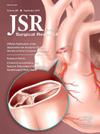Fibrinogen in Resuscitation of Older Adult Trauma Patients: Are They Too Old to Receive New Adjuncts?
IF 1.7
3区 医学
Q2 SURGERY
引用次数: 0
Abstract
Introduction
Trauma-induced coagulopathy occurs in a quarter of injured patients and increases the risk of mortality. Recent studies suggest that fibrinogen supplementation (FS), when used as an adjunct for resuscitation, is associated with improved outcomes. There is a lack of data on the role of pharmacologic adjuncts in hemorrhaging older adult (OA) trauma patients. The aim of our study was to compare the outcomes of patients receiving FS as an adjunct to the standard of care among OA versus young adult (YA) trauma patients.
Methods
We performed a 4-y (2017-2020) retrospective analysis of the American College of Surgeons Trauma Quality Improvement Program database. All adult (age ≥18 y) trauma patients with a shock index > 1 who received early (≤4 h) FS, including fibrinogen concentrate (FC) or cryoprecipitate (Cryo), were included. We excluded patients dead on arrival, those transferred from other facilities, those with bleeding disorders or chronic liver disease, and those on preinjury anticoagulation. Patients were stratified into YA (18-64 y) and OA (≥ 65 y). Primary outcomes were 6-h and 24-h mortality. Secondary outcomes were included in-hospital mortality, major complications, and 4-h blood transfusion requirements. Multivariable regression analyses were performed to identify the independent association of age on the outcomes.
Results
A total of 7103 patients were identified, of which 999 (14.06%) were OA. On presentation, the mean shock index was 1.4, and both study groups had comparable median Injury Severity Score. The median time to FC and Cryo administration was 59 and 120 min, respectively. Overall, the rates of 6-h, 24-h, and in-hospital mortality were 11.1%, 20.6%, and 38.9%, respectively. On multivariable regression analysis, age was not associated with 6-h mortality (adjusted odds ratio [aOR]: 1.20, 95% confidence interval [CI] [0.95-1.52], P = 0.125), 24-h mortality (aOR: 1.12, 95% CI [0.87-1.43], P = 0.379), and major complications (aOR: 0.79, 95% CI [0.83-1.27], P = 0.125). However, OA had independently higher risk-adjusted odds of in-hospital mortality (aOR: 1.96, 95% CI [1.59-2.41], P < 0.001). Notably, older age was associated with a 5.27-unit decrease in packed red blood cell, 2.82-unit decrease in fresh frozen plasma , and 1.63-unit decrease in platelet requirements at 4 h. A subanalysis of patients receiving Cryo (n = 6409) or FC (n = 694) showed the same trend of outcomes.
Conclusions
FS was associated with early outcomes that were broadly comparable between OA and YA. Despite higher in-hospital mortality, older age was associated with a reduction in blood product transfusion compared with younger patients.
纤维蛋白原在老年创伤患者复苏中的作用:他们是否太老而不能接受新的辅助治疗?
引言:创伤性凝血功能障碍发生在四分之一的受伤患者中,并增加了死亡风险。最近的研究表明,纤维蛋白原补充(FS),当用作辅助复苏时,与改善的结果相关。目前缺乏药物辅助治疗在出血性老年外伤患者中的作用的数据。本研究的目的是比较OA患者和年轻成人(YA)创伤患者接受FS作为标准治疗的结果。方法:我们对美国外科医师学会创伤质量改善计划数据库进行了为期4年(2017-2020)的回顾性分析。所有休克指数>.1的成人(年龄≥18岁)创伤患者均接受早期(≤4小时)FS,包括纤维蛋白原浓缩物(FC)或冷冻沉淀(Cryo)。我们排除了到达时死亡的患者、从其他设施转移过来的患者、有出血性疾病或慢性肝病的患者以及损伤前抗凝治疗的患者。患者分为YA(18-64岁)和OA(≥65岁)。主要结局为6小时和24小时死亡率。次要结局包括住院死亡率、主要并发症和4小时输血需求。进行多变量回归分析以确定年龄与结果的独立关联。结果:共发现7103例患者,其中OA 999例(14.06%)。在就诊时,平均休克指数为1.4,两个研究组的损伤严重程度评分中位数相当。到FC和Cryo给药的中位时间分别为59和120分钟。总体而言,6小时、24小时和住院死亡率分别为11.1%、20.6%和38.9%。在多变量回归分析中,年龄与6小时死亡率(校正优势比[aOR]: 1.20, 95%可信区间[CI] [0.95-1.52], P = 0.125)、24小时死亡率(aOR: 1.12, 95% CI [0.87-1.43], P = 0.379)和主要并发症(aOR: 0.79, 95% CI [0.83-1.27], P = 0.125)无关。然而,OA具有较高的住院死亡率(aOR: 1.96, 95% CI [1.59-2.41], P < 0.001)。值得注意的是,年龄越大,4小时内红细胞减少5.27个单位,新鲜冷冻血浆减少2.82个单位,血小板需求减少1.63个单位。对接受Cryo (n = 6409)或FC (n = 694)治疗的患者进行的亚分析显示出相同的结果趋势。结论:FS与OA和YA的早期预后大体相似。尽管住院死亡率较高,但与年轻患者相比,年龄较大的患者输血量减少。
本文章由计算机程序翻译,如有差异,请以英文原文为准。
求助全文
约1分钟内获得全文
求助全文
来源期刊
CiteScore
3.90
自引率
4.50%
发文量
627
审稿时长
138 days
期刊介绍:
The Journal of Surgical Research: Clinical and Laboratory Investigation publishes original articles concerned with clinical and laboratory investigations relevant to surgical practice and teaching. The journal emphasizes reports of clinical investigations or fundamental research bearing directly on surgical management that will be of general interest to a broad range of surgeons and surgical researchers. The articles presented need not have been the products of surgeons or of surgical laboratories.
The Journal of Surgical Research also features review articles and special articles relating to educational, research, or social issues of interest to the academic surgical community.

 求助内容:
求助内容: 应助结果提醒方式:
应助结果提醒方式:


